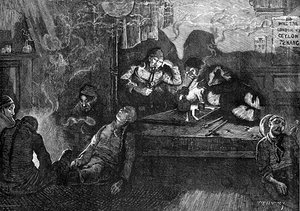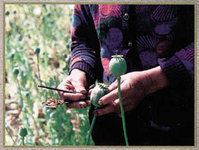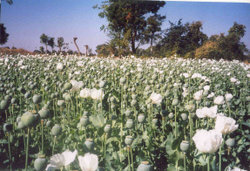Anglo-European Science and the Rhetoric of Empire: Malaria, Opium, and British Rule in India, 1756-1895, by Paul C. Winther. Lanham, Maryland, Lexington Books, 2003. xviii, 429 pp. $90.00 US (cloth).
In the recent historiography of British imperialism few topics have enjoyed as much renewed interest among scholars as have science, medicine, and missionary evangelism. In this book, Paul C. Winther has provided a meticulously-researched study of how all these aspects converged in one of the more controversial episodes of British rule in India: the state-sanctioned production and marketing of opium to Indian and Chinese consumers. In the late eighteenth century and throughout the nineteenth century, the Government of India regulated the production of opium for distribution to China, thus ensuring a steady flow of revenue to its treasury in Calcutta and providing the key to the domination of East Asian markets. Despite the profitability of the opium trade, the rise of missionary activity throughout the empire led to an increasingly vocal condemnation of this "infernal revenue" (p.1) and eventually threatened its demise once the Liberals came to power in Westminster in the late nineteenth century. The struggle between the pro-trade and anti-trade forces in Britain and the empire culminated in the Royal Commission on Opium, convened in 1893 to decide the future of this enterprise. Throughout the hearings, each side marshaled all available scientific evidence to argue either for the medicinal benefits of opium use or the addictive and physiologically and morally destructive powers of the substance upon its hapless victims. Central to the pro-trade argument was the dubious claim that narcotine, the active agent in opium, functioned as a preventive and curative treatment for malaria.
The main argument of the book centres around the selective use of the "drug-disease" theory by the Government of India to legitimize and protect its own political and economic stake in the opium trade. According to Winther, this "medical misconception" was merely a tactic by British officials in India to maintain their hegemony over the subcontinent and their political and financial autonomy from London (p. 4). Winther begins by describing the parallel development of imperial politics, missionary evangelism, and scientific theory during the heyday of the East India Company and in the early years of the British raj. He outlines the growth of poppy cultivation in the Indian subcontinent and the forcing open of Chinese markets in the Opium War of 1840-42, as well as highlighting contemporary scientific explanations of the physiological effects of the drug itself. The book then traces the rise of missionary activity in both China and India and the dismay of these evangelists in attempting to convert and shepherd a drug-addled and despondent flock. The moral outrage of the missionaries at the insidious activity of their own government went largely unanswered in the late eighteenth and early nineteenth centuries as commercial gain drove the engine of imperial expansion. Yet by the end of the nineteenth century - the apogee of the Victorian Age - the moral justification for the empire and the scientific knowledge of the effects of opium use could no longer ensure that this drug trade would go unchallenged. In the 1870s, anti-trade activists founded the Society for the Suppression of the Opium Trade (SSOT) and took their case to Parliament. Defenders of the trade countered the anti-opiumists with their own moral and scientific argument rooted in the Indian folk belief that the ingestion of opium prevented and cured malaria.
When the Royal Commission on Opium began taking witness testimony, numerous experts and quasi-experts attested to the traditional medicinal uses of the drug among the population, which ranged from alleviating indigestion and numbing pain to curing "malarial fever." According to these witnesses, many of whom were career officers of the Indian Medical Service, Indians across the subcontinent engaged in the practice of eating opium, and for many it was the only available remedy for numerous health conditions for which other more sophisticated treatments, such as quinine, would have been prohibitively expensive. The testimony of Sir William Roberts, a renowned physician and medical researcher, was particularly instrumental in undercutting the anti-opiumists' argument and driving them from the moral high ground. Roberts and other likeminded witnesses testified that the health hazards and narcotic effect of opium use, if used in moderation, were no worse than those of alcohol consumption and therefore no more grounds for the abolition of the opium trade in India than for the closing of all pubs and taverns in Britain. Moreover, the encouragement of abstinence or even underconsumption among the poorest residents in highly malarial areas would actually cause needless suffering and death on a grand scale. The tables were thus turned on the anti-opiumists, who now came across as preening and sanctimonious hypocrites against whose ignorant moralizing the pro-trade advocates were attempting to protect the weakest and most physically vulnerable of India's masses. According to Winther, "Robert's assessment provided the Government of India with a tactical flexibility to neutralize SSOT opposition that it lacked prior to the creation of the Royal Commission on Opium" (p. 302). Ultimately, the commission ruled in favour of the continuance of the trade, thus preserving this economic pillar of the raj.
The topic of this study is fascinating, and the research presented is indeed impressive, but the book as a whole suffers from several serious flaws. The most significant of these is a noticeable absence of effective editing. Many of the chapters in the book are divided into idiosyncratic subsections and give page after page of unprocessed and tedious information and statistics that risk losing the attention of even the most interested reader. The arrangement of some statistical information in six appendices is helpful, but unfortunately it does little to diminish the sense of information overkill that pervades most of the narrative of the book itself. For example, there is simply no need to relate the testimony, or give a biographical background of nearly every witness who testified before the opium commission. Chapters five and six, in particular, are little more than a rearranged and exhausting presentation of the commission's record of witness testimony. Additionally, the method of citation used (even as the rationale is explained in the preface) does not work effectively with historical sources, and the inclusion of lengthy parenthetical citations frequently inhibits the smooth flow of the narrative. It is regrettable that the author and his editors did not take the time to synthesize and condense these data and sources into a more compelling and readable narrative. Had this book been half as long it would have been twice as effective.
David A. Campion
Lewis & Clark College, Portland, Oregon
Copyright Canadian Journal of History Dec 2004
Provided by ProQuest Information and Learning Company. All rights Reserved




